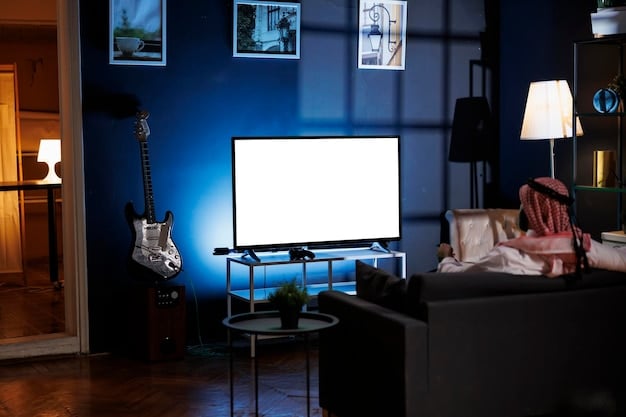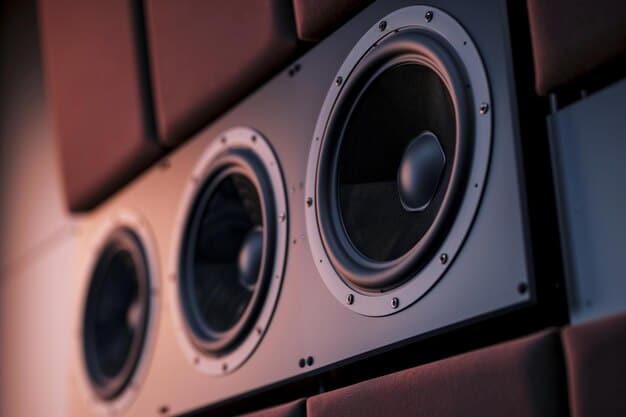Streaming Quality Showdown: Best Picture and Sound in Brazil

The ultimate streaming quality showdown: which platform offers the best picture and sound in Brazil? Delving into the intricate world of streaming in Brazil reveals that platforms like Netflix, Max, and Prime Video lead the charge with superior video resolutions and immersive audio experiences, fundamentally shaping viewer expectations through advanced technological implementations and local content strategies.
In the vibrant and rapidly evolving landscape of digital entertainment, the question of which streaming platform delivers the ultimate visual and auditory experience has never been more pertinent. This streaming quality showdown: which platform offers the best picture and sound in Brazil? seeks to dissect the complexities behind resolution, audio codecs, and content delivery networks, providing clarity on how these elements shape your home viewing pleasure. Join us as we explore the nuances that differentiate the top contenders in the Brazilian market.
the evolution of streaming quality standards
The journey of streaming quality has been a remarkable one, transitioning from pixelated early days to the breathtaking clarity we often take for granted today. This evolution is not merely about increasing resolution; it encompasses sophisticated codecs, adaptive bitrate streaming, and robust content delivery networks (CDNs). Understanding these technological underpinnings is crucial to appreciating the current state of streaming excellence, especially in a dynamic market like Brazil.
Early streaming efforts were hampered by limited bandwidth and less efficient compression technologies. Viewers often tolerated lower resolutions and frequent buffering in exchange for on-demand access to content. However, as internet infrastructure improved globally, and especially within key markets like Brazil, the demand for higher fidelity experiences grew exponentially. This fostered a competitive environment among streaming providers, driving innovation in areas like 4K/UHD resolution, HDR (High Dynamic Range), and immersive audio formats.
technological leaps impacting resolution
The leap from standard definition (SD) to high definition (HD) was a significant milestone, making content sharper and more detailed. Yet, the true game-changer arrived with Ultra High Definition (UHD) or 4K, quadrupling the pixel count of Full HD. This enhancement brings unparalleled clarity and allows for larger screen sizes without loss of picture quality. Furthermore, the advent of HDR technologies has revolutionized how colors and contrast are displayed, offering a more vibrant and lifelike image than ever before. Dolby Vision and HDR10+ are leading formats in this space, dynamically adjusting visual settings scene by scene.
- 4K/UHD Resolution: Offers four times the pixels of 1080p Full HD, providing significantly sharper images.
- HDR (High Dynamic Range): Enhances contrast and color accuracy, producing brighter whites and deeper blacks.
- Adaptive Bitrate Streaming: Adjusts video quality in real-time based on internet speed, minimizing buffering.
These advancements necessitated improvements in video compression. Modern codecs like HEVC (High Efficiency Video Coding) are instrumental, allowing higher quality video to be streamed efficiently over existing internet connections. This balance between quality and bandwidth efficiency is paramount for delivering a seamless viewing experience to a broad audience, encompassing varying internet speeds across Brazil.
advancements in audio immersive experiences
Picture quality often takes center stage, but audio is equally vital for a truly immersive experience. From basic stereo to surround sound and now object-based audio, the evolution has transformed how we perceive sound in films and series. Formats like Dolby Atmos and DTS:X have redefined home audio, allowing sound engineers to place and move individual sounds in a three-dimensional space, creating a more realistic and engaging soundscape.
In Brazil, where many households enjoy home theater setups, the availability of content with advanced audio tracks is a significant differentiator. Platforms investing in these technologies offer a more premium experience, appealing to audiophiles and casual viewers alike. The interplay between visual and auditory excellence is what truly defines a superior streaming service, moving beyond mere content availability to a holistic entertainment package.
The journey of streaming quality is one of continuous innovation, driven by consumer demand and technological breakthroughs. As internet speeds increase and display technologies become more sophisticated, the bar for picture and sound quality will continue to rise, promising ever more breathtaking experiences for viewers in Brazil and worldwide.
key contenders in brazil: netflix, max, and prime video
Brazil’s streaming market is robust, with several global giants vying for subscribers. Among them, Netflix, Max (formerly HBO Max), and Prime Video consistently emerge as top contenders, each with its unique strengths in delivering high-quality visual and audio experiences. Evaluating these platforms involves looking beyond their content libraries to their technical specifications and how they optimize for the Brazilian internet infrastructure.
These platforms have invested heavily in localizing their content, but also in ensuring their technical delivery meets the high expectations of their discerning audience. The competitive landscape pushes each service to innovate, not just in content acquisition, but also in the underlying technology that powers the user experience.
netflix: a pioneer in 4k and hdr streaming
Netflix has long been a frontrunner in adopting and propagating high-quality streaming standards. It was among the first to widely offer 4K UHD content and implement HDR formats like Dolby Vision and HDR10. Their extensive library of original content, much of which is produced in 4K with HDR, positions them strongly regarding visual fidelity. For audio, Netflix supports Dolby Atmos on many titles, offering an object-based immersive sound experience.
- Dolby Vision Support: Widely available on compatible devices and content, enhancing visual depth.
- Extensive 4K Library: A vast catalog of original series and films produced and streamed in 4K.
- Dolby Atmos Audio: Delivers immersive, multidimensional sound for an enhanced auditory experience.
However, accessing Netflix’s highest quality streams, particularly 4K HDR with Dolby Atmos, typically requires a premium subscription tier. This pricing strategy reflects the significant investment in bandwidth and content production required to maintain such high standards. In Brazil, where broadband speeds can vary, Netflix’s adaptive bitrate streaming is crucial, dynamically adjusting quality to prevent buffering, though this may mean not always streaming at peak resolution.
max: premium content with evolving quality
Max, known for its premium content and cinematic quality productions, also offers a significant portion of its library in 4K UHD with HDR (primarily HDR10) and Dolby Atmos audio. Its strength lies in delivering high-fidelity versions of critically acclaimed series and blockbuster movies, often directly from their theatrical or television debuts. The platform’s commitment to visual and audio excellence is evident in its flagship productions.

Max’s approach often emphasizes the “cinematic” experience, which extends to ensuring the best possible technical delivery. While its 4K and HDR content might not be as universally pervasive across its entire library as Netflix’s, its highly anticipated releases are consistently of superior quality. Users in Brazil can expect a premium viewing experience from Max, especially for their original series and major film releases, although subscription pricing aligns with this premium offering.
prime video: strong contender with diverse content
Amazon Prime Video has steadily grown its high-quality content offerings, including a growing selection of 4K UHD and HDR titles (supporting HDR10 and HDR10+). Many of its original series are available in these formats, and the platform has also expanded its support for Dolby Atmos audio. Prime Video’s unique value proposition often includes its bundling with other Amazon Prime benefits, making its premium quality accessible to a broader audience.
The platform’s technical performance in Brazil is generally robust, leveraging Amazon’s extensive AWS infrastructure to deliver content efficiently. While its content library is eclectic, the emphasis on producing high-quality original series has elevated its standing in the streaming quality showdown. Prime Video constantly updates its technical capabilities to match or exceed competitors, ensuring a competitive edge in delivering a premium viewing experience to its Brazilian subscribers.
In summary, all three platforms offer compelling high-quality streaming experiences in Brazil. Netflix stands out for its extensive 4K HDR library, Max for its cinematic premium content, and Prime Video for its competitive quality offerings integrated with broader Prime benefits. The choice often comes down to content preference and specific technical features compatible with a user’s home entertainment setup.
understanding resolution and hdr standards in brazil
Navigating the world of streaming quality means getting to grips with technical terms like resolution and HDR. In Brazil, just as elsewhere, these standards dictate the level of detail and color vibrancy you see on your screen. A clear grasp of what 4K, HDR10, Dolby Vision, and HLG mean will empower you to make informed decisions about your streaming subscriptions and equipment.
It’s not just about having a 4K TV; it’s about the content being streamed in 4K, and whether your device can properly decode and display the associated HDR information. This ecosystem involves the streaming platform, your internet speed, your viewing device, and even the cables connecting them.
the nuances of 4k and ultra hd
While often used interchangeably, 4K and Ultra HD (UHD) refer to a resolution of 3840 x 2160 pixels. This is a significant jump from 1920 x 1080 (Full HD), offering four times the pixel count. The benefit is most noticeable on larger screens, where individual pixels become less visible, resulting in a smoother, more detailed image. For viewers in Brazil, access to 4K content largely depends on their internet service provider (ISP) as well as the streaming platform’s offerings.
Streaming 4K content requires a robust internet connection, ideally 25 Mbps or higher, to ensure a smooth, buffer-free experience. Most major streaming services automatically adjust the resolution based on available bandwidth, so even if you have a 4K display, you might not always be receiving a 4K stream if your internet fluctuates. This adaptability is key to maintaining a watchable experience across diverse internet conditions within Brazil.
decoding hdr: hdr10, dolby vision, and hlg
HDR is arguably as important as resolution, if not more so, in enhancing picture quality. It expands the range of both color and contrast, making whites brighter and blacks deeper, with a wider spectrum of colors in between. This leads to a more realistic and impactful image. There are several competing HDR formats, each with its own advantages and market adoption:
- HDR10: The open standard and most common HDR format. It provides static metadata for the entire video.
- Dolby Vision: A proprietary standard that uses dynamic metadata, allowing for scene-by-scene or even frame-by-frame optimization of brightness, contrast, and color.
- HLG (Hybrid Log-Gamma): Primarily used for broadcast TV, it is backward-compatible with SDR displays.
In Brazil, many modern TVs support multiple HDR formats, but checking specific device compatibility with Dolby Vision or HDR10+ is important if you want to experience content in its highest fidelity. Streaming platforms typically specify which HDR formats they support for certain titles, allowing users to verify if their setup can leverage these advanced visual enhancements. The dynamic nature of Dolby Vision often provides a perceptibly superior image compared to static HDR10, though both offer significant upgrades over SDR.
Understanding these standards helps Brazilian consumers differentiate between what promises high quality and what actually delivers it, ensuring their streaming experience matches their expectations and hardware capabilities.
the role of audio codecs: dolby atmos vs. dts:x
While visual clarity captures immediate attention, the audio experience is equally, if not more, critical for true immersion. In the realm of high-fidelity streaming, object-based audio formats like Dolby Atmos and DTS:X have revolutionized how sound is delivered, allowing for a three-dimensional soundscape that places you right in the middle of the action. Understanding their differences and availability in Brazil is key for audiophiles and home theater enthusiasts.
These advanced audio codecs go beyond traditional channel-based surround sound, offering a more dynamic and intricate audio experience. They represent the pinnacle of current home audio technology, bringing cinematic sound quality into the living room.
dolby atmos: leading the immersive sound experience
Dolby Atmos is widely regarded as the leading immersive audio format in the streaming world. It adds a height dimension to traditional surround sound, allowing sound designers to place and move individual “objects” of sound anywhere in a 3D space. This means a helicopter can sound like it’s flying overhead, or rain can seem to fall from the ceiling, creating a highly realistic and enveloping auditory environment.
For streaming in Brazil, Netflix, Max, and Prime Video all offer a significant number of titles with Dolby Atmos soundtracks. To experience Dolby Atmos, you typically need a compatible soundbar or AV receiver, along with speakers capable of producing height effects (either upward-firing or ceiling-mounted). The audio data is often carried within the Dolby Digital Plus codec for streaming, which is more efficient for internet delivery than uncompressed formats, making it suitable for varying internet speeds across Brazil.
dts:x: an alternative immersive audio format
DTS:X is another object-based audio format, developed as a direct competitor to Dolby Atmos. Like Atmos, it allows for sound objects to be placed and moved in a three-dimensional space, providing a similar immersive experience. One of DTS:X’s touted advantages is its flexibility in speaker placement, as it’s not as reliant on specific configurations as some other formats. However, its adoption in streaming services is less widespread than Dolby Atmos in Brazil.

While DTS:X is popular in Blu-ray discs, its presence on major streaming platforms in Brazil is limited. This means that if immersive audio is a priority, and you are choosing between a sound system that supports only one format, Dolby Atmos compatibility will likely offer a broader selection of content. The differences in perceived sound quality between Atmos and DTS:X are often subtle and depend heavily on the sound mix of the content and the quality of your audio equipment.
Ultimately, the presence of these advanced audio codecs significantly elevates the streaming experience, pushing it beyond mere viewing into a full sensory engagement. For Brazilian consumers, investing in equipment capable of decoding Dolby Atmos is more likely to yield a consistent high-quality audio experience across the most popular streaming platforms.
internet speed and device compatibility in brazil
The quest for the best streaming quality in Brazil isn’t just about what the platforms offer; it’s also heavily reliant on your internet connection and the capabilities of your viewing devices. Even the most advanced 4K HDR and Dolby Atmos content will fall short if your internet speed can’t keep up or your TV and sound system aren’t compatible.
Understanding the interplay between these elements is crucial for maximizing your streaming experience and avoiding disappointment. Brazil’s diverse internet infrastructure means that what works perfectly in a major city might be a struggle in a more rural area.
recommended internet speeds for high-quality streaming
Streaming in 4K UHD with HDR and immersive audio demands substantial bandwidth. While platforms can adapt to slower speeds by downscaling quality, a consistent high-quality experience requires a robust internet connection. Here’s a general guideline for recommended speeds:
- SD Quality (480p): 3 Mbps
- HD Quality (720p/1080p): 5-10 Mbps
- 4K UHD Quality: 25 Mbps or higher
These are minimum recommendations; having a faster connection (e.g., 50-100 Mbps or more for fiber optic) provides a larger buffer against network fluctuations and allows for multiple devices to stream simultaneously without compromising quality. In Brazil, fiber optic internet is becoming increasingly available in urban centers, drastically improving the potential for high-quality streaming.
Beyond raw speed, the stability and latency of your connection also play a significant role. A connection with low latency and consistent speeds will offer a smoother, buffer-free streaming experience, even if the peak bandwidth is slightly lower than ideal. Using a wired Ethernet connection to your streaming device, rather than Wi-Fi, can also improve stability and reduce potential interference.
device compatibility: tvs, sound systems, and streaming players
To fully enjoy 4K HDR and immersive audio, your entire entertainment chain needs to be compatible. This means more than just a 4K TV; it involves the TV’s specific HDR support, the capabilities of your sound system, and the streaming device you’re using.
A 4K TV is essential, but check if it supports HDR10, Dolby Vision, or both. Many newer TVs are equipped with these capabilities, but older models might only support basic 4K. For audio, a compatible soundbar or AV receiver with support for Dolby Atmos or DTS:X is necessary, along with speakers capable of delivering height effects. The streaming player (e.g., smart TV apps, dedicated streaming boxes like Apple TV 4K, Roku, or Fire TV Stick 4K) must also be able to decode and pass through the high-quality video and audio signals. Newer generations of streaming devices are generally better equipped to handle these demands.
Understanding these compatibility requirements is crucial for Brazilian consumers. It helps prevent investing in a premium streaming subscription only to find their existing equipment cannot display or play the content at its advertised quality. A thorough check of device specifications before subscribing to higher tiers is always advisable.
content library and exclusive offerings in brazil
The ultimate determination of which streaming platform offers the best picture and sound in Brazil is not solely a technical one; it’s also deeply intertwined with the content available. What good is pristine 4K HDR with Dolby Atmos if the shows and movies you want to watch aren’t offered in those formats, or aren’t available at all? The content library, particularly exclusive original programming, plays a significant role in where consumers choose to invest their streaming budget.
Each major platform has carved out its niche, investing heavily in exclusive series and films that often serve as the standard-bearer for their highest quality technical specifications. These originals are crucial in defining a platform’s premium experience.
original productions: setting the quality bar
Netflix, Max, and Prime Video all pour billions into original content, much of which is produced with the highest technical standards in mind. Netflix has an expansive catalog of “Netflix Originals” available in 4K HDR and Dolby Atmos, ranging from dramas and comedies to documentaries. This consistent investment ensures that a significant portion of their new releases showcases the platform’s top-tier capabilities.
Max is renowned for its pedigree in producing critically acclaimed, cinematic series (many inheriting HBO’s legacy), which are almost invariably offered in 4K HDR and Dolby Atmos for compatible devices. This focus on premium, less voluminous but high-impact content makes it a compelling choice for those seeking a “theater-like” experience at home.
Prime Video has also made substantial strides with its “Amazon Originals,” featuring series and movies produced in 4K HDR (often HDR10+) and Dolby Atmos. Their strategy combines a diverse range of genres with a strong technical presentation, making them a formidable competitor in the quality stakes.
licensed content: variations in availability and quality
While originals are usually a safe bet for high quality, the picture for licensed content can be more varied. Older films or series licensed from third parties might only be available in HD, even on platforms that excel in 4K. This is often due to the source material not being available in a higher resolution or the licensing agreement not covering enhanced formats. For Brazilian viewers, this means that while a platform might technically support 4K, not all content within its library will stream at that resolution.
Netflix, for instance, has a mix of licensed content; some are upscaled, while others are available in HD. Max relies heavily on the Warner Bros. library, with new theatrical releases often coming to the service in 4K HDR shortly after their cinema run. Prime Video’s licensed content also varies, but they often offer purchase or rental options for 4K versions of films not available in 4K via subscription.
Therefore, a comprehensive assessment of streaming quality in Brazil must consider not only what a platform *can* deliver, but what content *is* consistently delivered at the highest possible quality. Researching specific titles you intend to watch can provide clearer insights into the actual quality you’ll experience.
user experience, interface, and performance in brazil
Beyond the raw technical specifications of picture and sound, the overall user experience (UX) and interface design significantly impact how consumers perceive streaming quality in Brazil. An intuitive interface, seamless navigation, and reliable performance are just as crucial as 4K resolution or Dolby Atmos audio. Issues like buffering, difficulty finding specific titles, or a cluttered UI can detract from even the best-quality content.
For Brazilian users, this translates to factors like app responsiveness across different devices, the accuracy of content recommendations, and the ease of managing profiles and viewing settings. A smooth and enjoyable user journey contributes immensely to overall satisfaction.
interface intuitiveness and navigation
Netflix is often lauded for its highly intuitive interface, which prioritizes content discovery and ease of navigation. Its personalized recommendation engine is a key feature, learning user preferences over time to suggest relevant titles. The platform’s consistent UI across various devices (smart TVs, mobile, web browsers) also contributes to a familiar and comfortable experience for Brazilian users.
Max offers a clean and visually appealing interface, although some users report it can be less intuitive for discovering new content compared to Netflix. Its strength lies in showcasing its premium series and films prominently. Prime Video’s interface can sometimes feel more cluttered due to its integration with the broader Amazon ecosystem, but recent updates have aimed to simplify navigation and improve content discoverability. For Brazilian users, finding content quickly and efficiently is paramount, as is the ability to easily access language and subtitle options.
performance and reliability
Consistency in performance is vital for a premium streaming experience. This includes minimal buffering, quick loading times for content, and stable playback. All three major platforms – Netflix, Max, and Prime Video – generally offer robust performance in Brazil, thanks to their extensive CDN networks distributed across the globe, including locally within Brazil.
However, localized factors such as the quality of the user’s internet service provider (ISP), the distance to the nearest CDN server, and internal home network congestion can influence individual performance. During peak hours, even with good internet, there might be slight degradations in streaming quality as services prioritize consistent playback over maximum resolution. Platforms like Netflix are known for their advanced adaptive bitrate streaming, which fluidly adjusts quality to maintain a smooth stream, an essential feature for the varying internet conditions found across Brazil.
Ultimately, while technical specs define potential, the user experience dictates daily enjoyment. A platform that combines high-quality content with a smooth, reliable, and user-friendly interface will consistently rank high in the minds of Brazilian consumers, making the overall streaming experience truly best-in-class.
| Key Point | Brief Description |
|---|---|
| 🎞️ Resolution Standards | 4K UHD (3840×2160) offers superior detail; requires stable internet and compatible display. |
| 🌈 HDR Formats | Dolby Vision and HDR10+ enhance color and contrast, providing a more vivid, lifelike image. |
| 🎧 Immersive Audio | Dolby Atmos leads in object-based sound, creating a 3D audio experience with height effects. |
| 🇧🇷 Brazil’s Context | Internet speed and device compatibility are crucial for maxing out streaming quality in the Brazilian market. |
frequently asked questions
▼
Netflix often leads in 4K content availability for its originals, with a vast library. Max is strong for cinematic releases, and Prime Video is catching up rapidly. Performance largely depends on your internet speed and device compatibility, but Netflix’s adaptive streaming is highly optimized for varying Brazilian internet conditions.
▼
No, typically only premium subscription tiers offer 4K UHD, HDR, and Dolby Atmos. Basic plans usually limit content to HD or even SD resolution. Always check the specific plan details before subscribing to ensure it meets your quality expectations, as this varies by platform in Brazil.
▼
For a smooth 4K streaming experience, a minimum stable internet speed of 25 Mbps is recommended by most platforms. However, 50 Mbps or higher is ideal, especially if multiple devices are streaming simultaneously or your internet connection tends to fluctuate in Brazil.
▼
Yes, major platforms like Netflix, Max, and Prime Video offer a significant number of titles with Dolby Atmos audio. Availability depends on the specific content and your audio equipment’s compatibility. Dolby Atmos is becoming a standard feature for premium streaming experiences in Brazil.
▼
Absolutely. Your TV must support 4K and relevant HDR formats (HDR10, Dolby Vision). For immersive audio, a compatible sound system (soundbar or AV receiver) is essential. Even your streaming device (smart TV app, streaming stick) needs to be capable of decoding and outputting these high-quality signals effectively.
conclusion
The pursuit of the best streaming quality in Brazil is a multifaceted endeavor, intertwining advanced technological capabilities with the realities of internet infrastructure and individual hardware. While platforms like Netflix, Max, and Prime Video consistently deliver impressive visual and auditory experiences through 4K UHD, HDR, and immersive audio formats like Dolby Atmos, the ultimate “best” is a subjective experience shaped by content preference, internet speed, and device compatibility. As the streaming landscape continues to evolve, consumers in Brazil benefit from an increasingly competitive market, driving innovation and raising the bar for home entertainment. Choosing the right platform involves a holistic assessment, ensuring an immersive and satisfying viewing journey tailored to your specific setup and desires.





